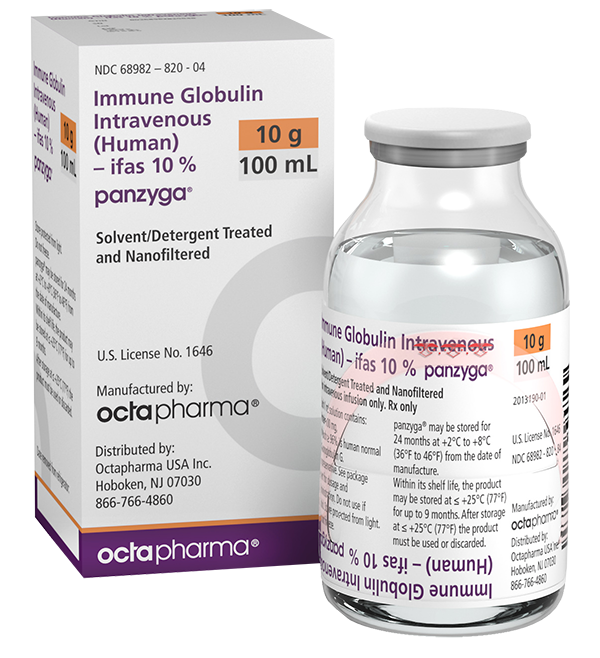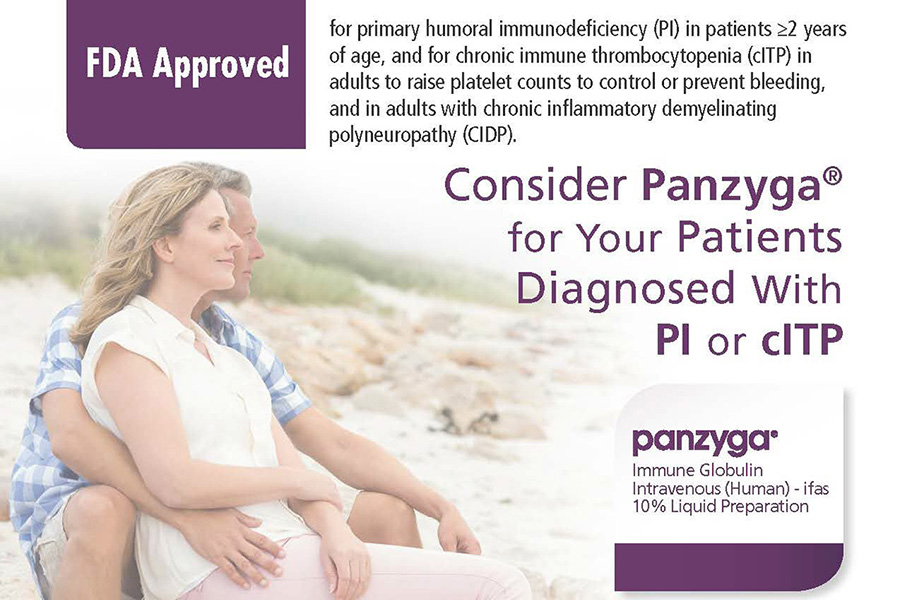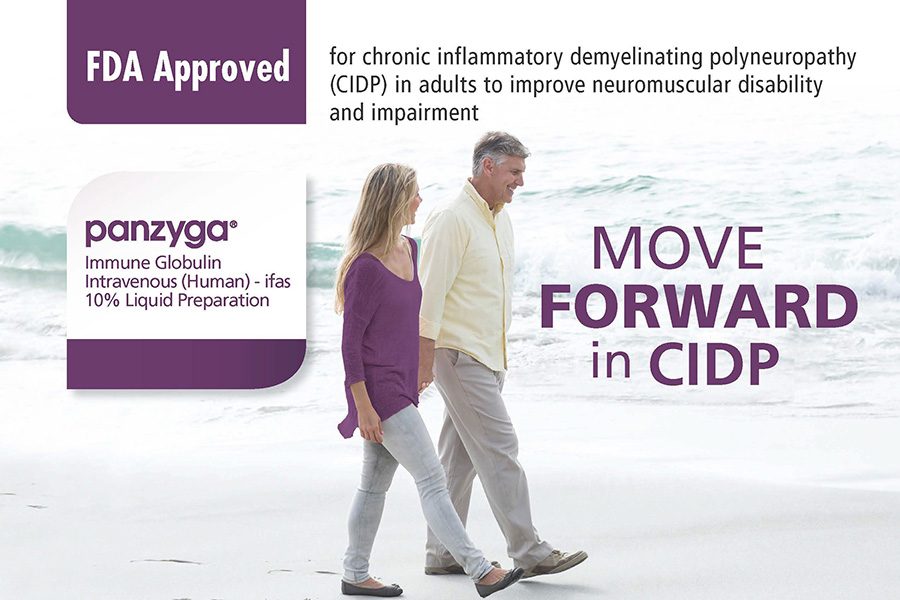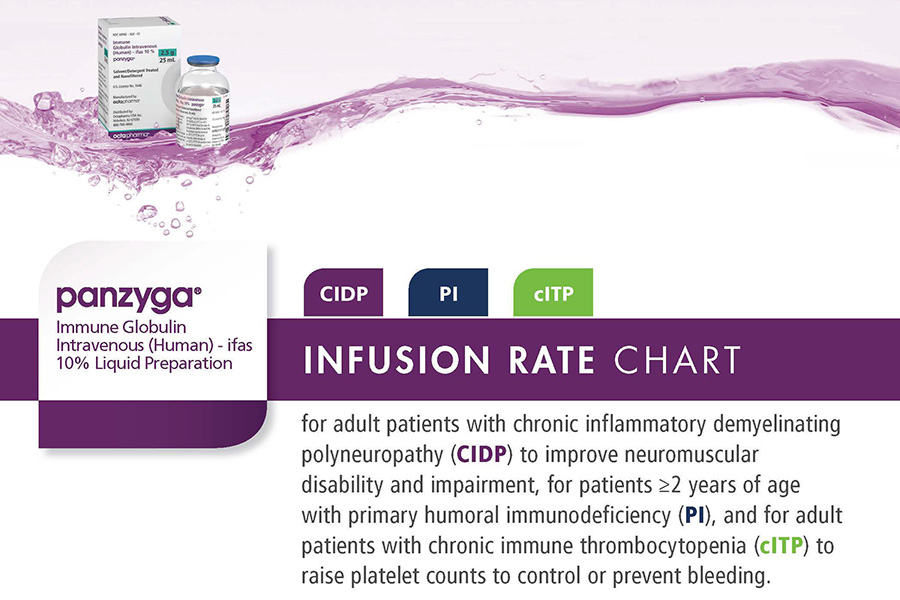Panzyga is
FDA-Approved
for Treatment of:
- Primary humoral immunodeficiency (PI) in patients 2 years of age and older
- Chronic immune thrombocytopenia (cITP) in adults to raise platelet counts to control or prevent bleeding
- Chronic inflammatory demyelinating polyneuropathy (CIDP) in adults to improve neuromuscular disability and impairment

Intravenous Immunoglobulin 10% in Children with Primary Immunodeficiency Diseases
Assessed the safety and efficacy of Panzyga in preventing serious bacterial infections (SBIs) in predominantly antibody-deficient children with PI disease, finding it effective, well tolerated, and safe for both children and adolescents during 12-15 months of treatment.1
Analyzed the efficacy and safety of Panzyga in preventing serious bacterial infections (SBIs) in patients with PI, finding that its use with antibody-deficient PI patients was associated with a low rate of adverse events (AEs) and was effective in preventing SBIs.2
Investigated the pharmacokinetics of Panzyga in patients aged 2-75 years with CVID or X-linked agammaglobulinaemia, finding its pharmacokinetic properties similar to those of other commercial preparations and that 3- or 4-weekly administration achieved sufficient concentrations of IgG/IgG subclasses/specific antibodies needed to prevent serious bacterial infections.3
Efficacy and Safety of a New Intravenous Immunoglobulin (Panzyga) in Chronic Immune Thrombocytopenia
Assessed the efficacy and safety of Panzyga, a novel human normal IVIg 10%, in adult patients with chronic ITP, finding it well tolerated even at a high infusion speed, inducing a rapid platelet count increase, thus decreasing rate and severity of bleeding events.4
ProCID Trial of Panzyga for CIDP
The Progress in Chronic Inflammatory Demyelinating polyneuropathy (ProCID) dose-ranging study investigated the efficacy, tolerability, and safety of a standard loading dose of Panzyga followed by 3 alternative maintenance dosing levels, finding that the 1.0 and 2.0 g/kg dosing levels were efficacious and well tolerated as maintenance treatment for CIDP in adults.5
A closer look at study design and protocol of the ProCID randomized, multicenter, phase III study of intravenous immunoglobulin 10% in adult patients with chronic inflammatory demyelinating polyradiculoneuropathy.6

Fast Facts: Panzyga for Treatment of PI & cITP
A handy reference overview of the safety, tolerability, and efficacy of Panzyga used in the treatment of PI and cITP, along with recommended dosing and administration rates for both disease states.

Fast Facts: Panzyga for Treatment of CIDP
A handy reference overview of the safety, tolerability, and efficacy of a standard loading dose and two FDA-approved maintenance dosing options for Panzyga used in the treatment of CIDP in adults.

For help calculating the appropriate infusion rate for loading and maintenance dosing for your patients with PI, cITP, and CIDP.
Keep Me Updated on Panzyga
If you'd like to talk to an Octapharma representative about Panzyga and stay current on product updates, just complete and submit the form.
"*" indicates required fields
References:
- Ochs HD, Melamed I, Borte M, et al. Intravenous immunoglobulin 10% in children with primary immunodeficiency diseases. Immunotherapy. 2018 Oct;10(14):1193-1202. doi:10.2217/imt-2018-0074
- Borte M, Melamed IR, Pulka G, et al. Efficacy and safety of human intravenous immunoglobulin 10% (Panzyga®) in patients with primary immunodeficiency diseases: a two-stage, multicenter, prospective, open-label study. J Clin Immunol. 2017;37(6):603-612. doi:10.1007/s10875-017-0424-4
- Melamed IR, Borte M, Trawnicek L, et al. Pharmacokinetics of a novel human intravenous immunoglobulin 10% in patients with primary immunodeficiency diseases: analysis of a phase III, multicentre, prospective, open-label study. Eur J Pharm Sci. 2018;118:80-86. doi:10.1016/j.ejps.2018.03.007
- Arbach O, Taumberger AB, Wietek S, Cervinek L, Salama A. Efficacy and safety of a new intravenous immunoglobulin (Panzyga®) in chronic immune thrombocytopenia. Transfus Med. 2019;29(1):48-54. doi:10.1111/tme.12573
- Cornblath DR, van Doorn PA, Hartung HP, et al. Randomized trial of three IVIg doses for treating chronic inflammatory demyelinating polyneuropathy. Brain. 2022 Apr 29;145(3):887-896. doi:10.1093/brain/awab422
- Cornblath DR, Hartung HP, Katzberg HD, Merkies ISJ, van Doorn PA. A randomised, multi-centre phase III study of 3 different doses of intravenous immunoglobulin 10% in patients with chronic inflammatory demyelinating polyradiculoneuropathy (ProCID trial): study design and protocol. J Peripher Nerv System. 2018;23:108-114. doi:10.1111/jns.12267
Terms of Use | Data Privacy Policy | California Required Statements
© 2024 Octapharma USA, Inc. All Rights Reserved | About Octapharma | PANZ-0309